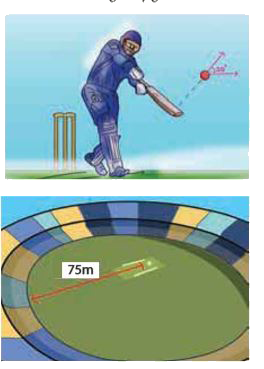In the cricket game, a batsman strikes the ball such that it moves with the speed 30ms−1 at an angle 30∘ with the horizontal as shown in the figure. The boundary line of the cricket ground is located at a distance of 75 m from the batsman? Will the ball go for a six? (Neglect the air resistance and take acceleration due to gravity g=10ms−2 ).

The motion of the cricket ball in air is essentially a projectile motion. As we have already seen, the range (horizontal distance) of the projectile motion is given by
R=u2sin2θg
The initial speed u=30ms−1
The projection angle θ=30∘
The horizontal distance travelled by the cricket ball
R=(30)2×sin60∘10=900×√3210=77.94m
This distance is greater than the distance of the boundary line. Hence the ball will cross this line and go for a six.
Topper's Solved these Questions
- KINEMATICSBOOK - NCERT TAMILCHAPTER - KINEMATICSEXERCISE - EXERCISE (I. Multi Choice Question)
15 Videos
- KINEMATICSBOOK - NCERT TAMILCHAPTER - KINEMATICSEXERCISE - EXERCISE (IV. Exercises )
20 Videos
- HEAT AND THERMODYNAMICSBOOK - NCERT TAMILCHAPTER - HEAT AND THERMODYNAMICSEXERCISE - EVALUATION (Numerical Problems)
13 Videos
- KINETIC THEORYBOOK - NCERT TAMILCHAPTER - KINETIC THEORYEXERCISE - ADDITIONAL EXERCISE
4 Videos
Similar Questions
The maximum height attained by a ball projected with speed 20ms−1 at an angle 45∘ with the horizontal is [take g = 10ms−2]
View SolutionA ball is projected from ground with a speed of 20ms−1 at an angle of 45∘ with horizontal.There is a wall of 25m height at a distance of 10m from the projection point. The ball will hit the wall at a height of
View Solution
Knowledge Check
The maximum height attained by a ball projected with speed 20ms−1 at an angle 45∘ with the horizontal is [take g = 10ms−2]
A40 mB20 mC10 mD30 mA cricketer of height 2.5m thrown a ball at an angle of 30∘ with the horizontal such that it is received by another crickerter of same height standing at distance of 50m from the first one.Find the maximum height attained by the ball.
A10mB9mC10.7mD9.7mA ball is thrown from the top of tower with an initial velocity of 10ms−1 at an angle of 30∘ with the horizontal. If it hits the ground of a distance of 17.3m from the back of the tower, the height of the tower is (Takeg=10ms−2)
A5mB20mC15mD10m
A cricket ball is thrown at a speed of 28ms−1 in a direction 30∘ above the horizontal. Calculate the time taken by the ball to return to the same level.
View SolutionA ball is projected form ground with a speed of 20ms−1 at an angle of 45∘ with horizontal.There is a wall of 25m height at a distance of 10m from the projection point. The ball will hit the wall at a height.
View SolutionA football is kicked with speed 20ms−1 at a projection angle of 45∘ from the ground. A receiver on the goal line 20m away in the disrection of the kich runs the same instant to meet the ball. What must he his speed, of he is to catch the ball cefore it hits the ground ? Take g=10ms−2.
View SolutionA ball is projected upwards from the top of a tower with a velocity 50ms−1 making an angle 30∘ with the horizontal. The height of tower is 70m. After how many seconds from the instant of throwing, will the ball reach the ground. (g=10ms−2)
View SolutionA man throws a ball at an angle of 45∘ with the horizontal plane from a height of 15 m. If the shot strikes the ground at a horizontal distance of 30 in, the velocity of throw is (Take g=10ms−2)
View Solution
